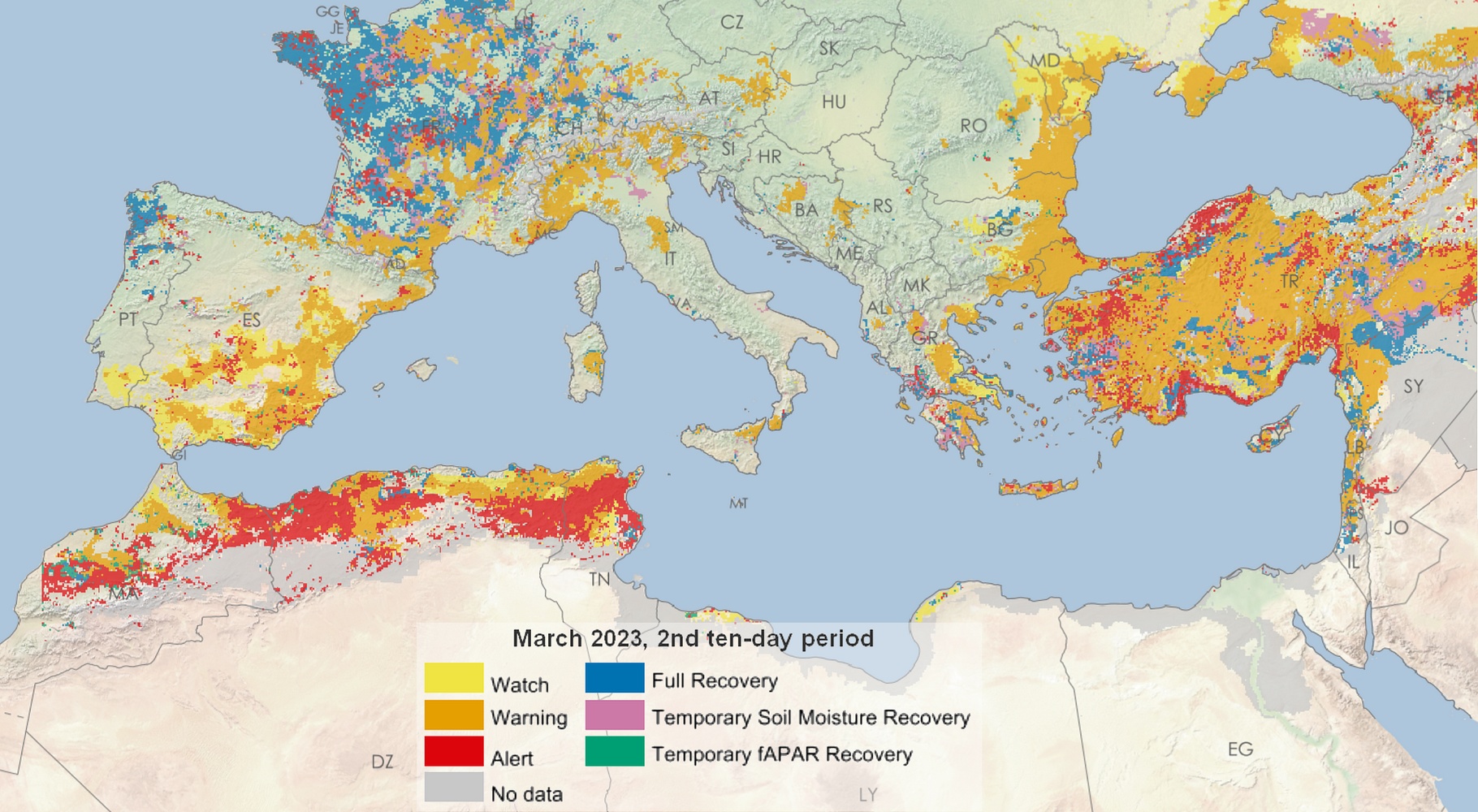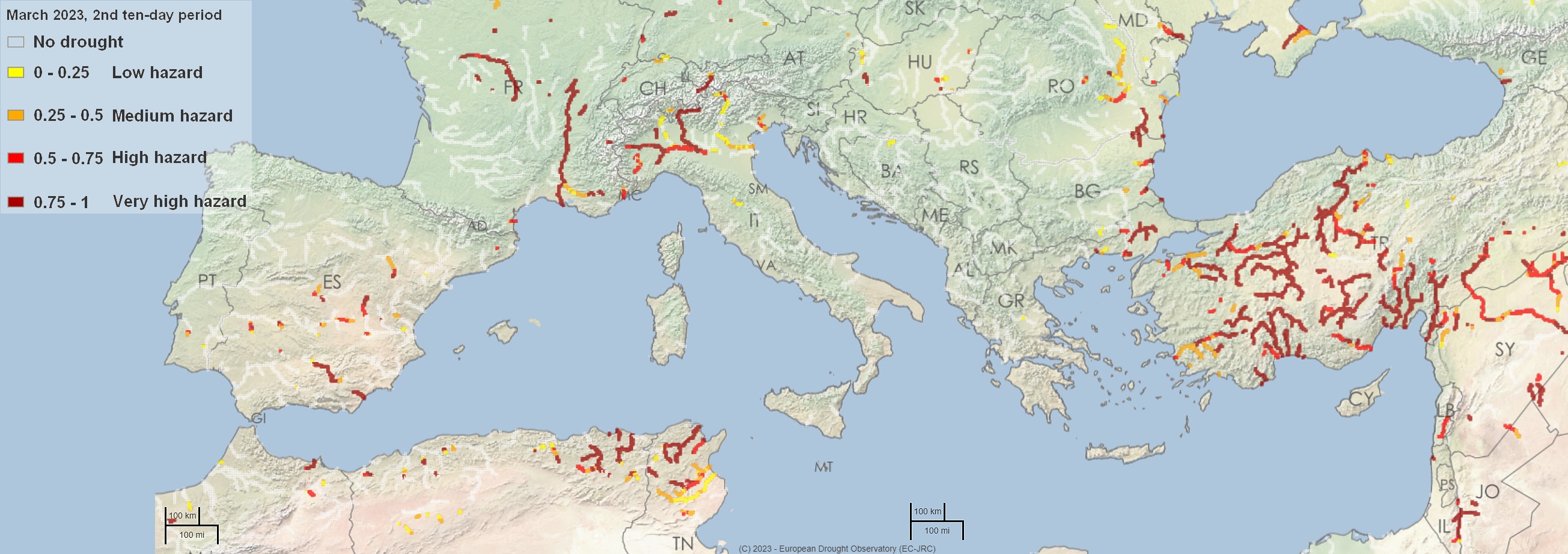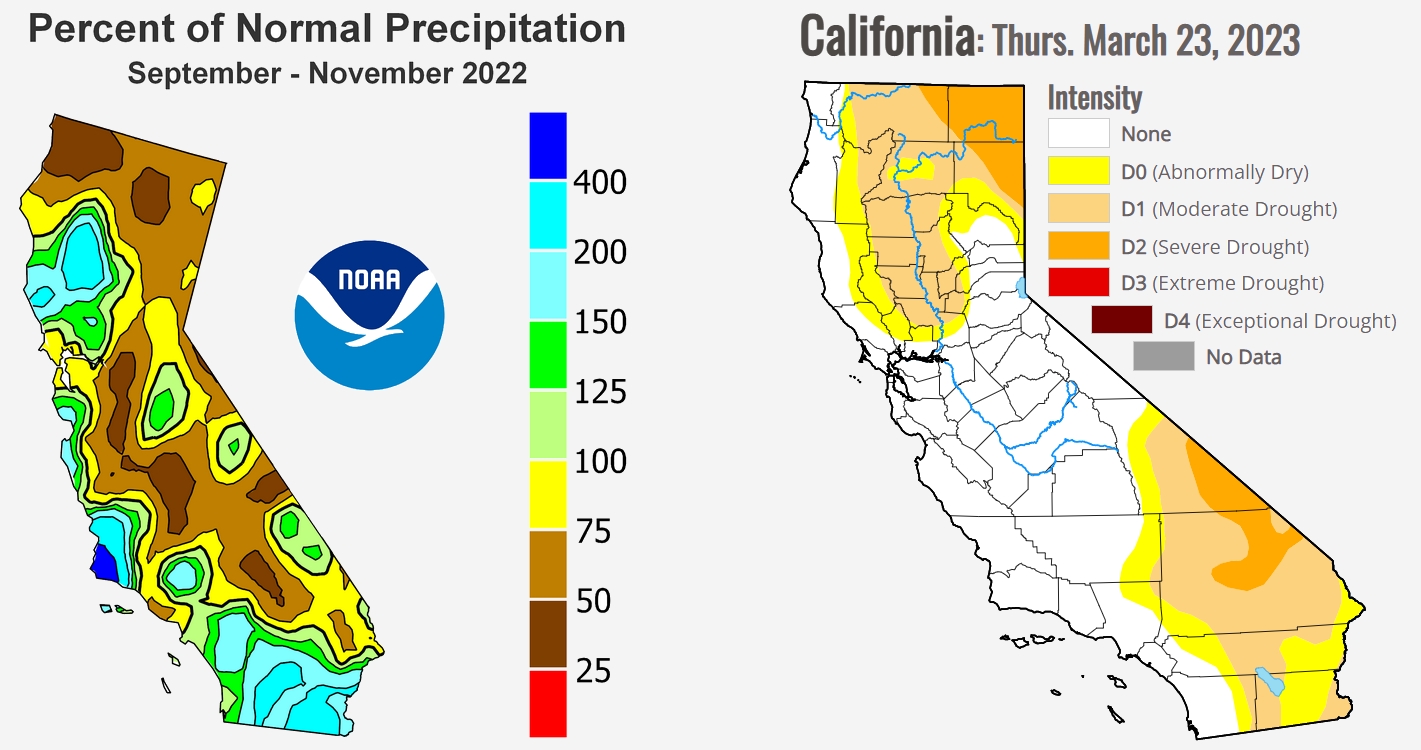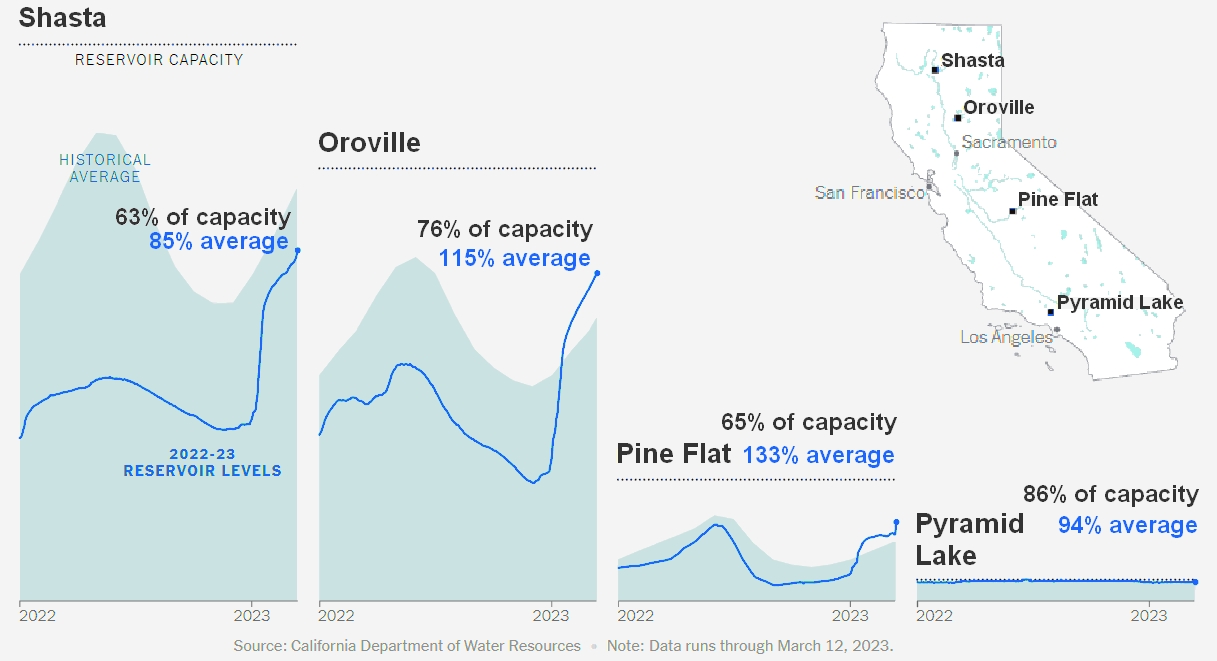Close monitoring and proper water use plans are required to deal with a season that currently has a high risk of being critical for water resources.
According to the latest report “Drought in Europe” issued by Copernicus in March 2023:
 Most of southern and western Europe is affected by substantial anomalies of soil moisture and river flow due to an exceptionally dry and warm winter.
Most of southern and western Europe is affected by substantial anomalies of soil moisture and river flow due to an exceptionally dry and warm winter. The snow water equivalent in the Alps is far below the historical average, and is even lower than that for the 2021-2022 winter. This will lead to severe reduction of snowmelt contribution to river flows in the perialpine region during spring and the early summer 2023.
The snow water equivalent in the Alps is far below the historical average, and is even lower than that for the 2021-2022 winter. This will lead to severe reduction of snowmelt contribution to river flows in the perialpine region during spring and the early summer 2023. Impacts of the emerging drought are already visible in France, Spain, and northern Italy and raise concerns on water supply, agriculture and energy production.
Impacts of the emerging drought are already visible in France, Spain, and northern Italy and raise concerns on water supply, agriculture and energy production. Seasonal forecasts show a warmer than average spring over Europe, while precipitation forecasts are characterized by higher spatial variability and uncertainty. Close monitoring and proper water use plans are required to deal with a season that currently has a high risk of being critical for water resources.
Seasonal forecasts show a warmer than average spring over Europe, while precipitation forecasts are characterized by higher spatial variability and uncertainty. Close monitoring and proper water use plans are required to deal with a season that currently has a high risk of being critical for water resources.
Dry conditions associated with potential impacts on water resources availability are emerging in wide areas of western and north-western Europe and several smaller areas in southern Europe, These late winter conditions are similar to the ones of 2022 which led to the severe-to-extreme drought and impacts later in that year.
The Combined Drought Indicator (CDI) at the end of February 2023 shows widespread warning conditions for drought in southern Spain, France, Ireland, the United Kingdom, Northen Italy, Switzerland, most Mediterranean islands, the Black Sea regions of Romania and Bulgaria, and Greece (see below).
The persistent lack of precipitation and a weeks-long sequence of warmer-than-average temperatures have led to negative soil moisture and river flow anomalies, particularly in southern Europe. Vegetation and crops at the beginning of the growing season have not been significantly affected yet, but the current situation may become critical in the coming months if temperature and precipitation anomalies will persist in spring 2023.
River flow
As of February 2023, the Low-Flow Index (LFI) shows critical values mainly over France, the United Kingdom, southern Germany, Switzerland, and northern Italy. The flow reduction clearly correlates with the severe lack of precipitation of the last months. River flows in the Rhône and the Pô basins are very low with a downward trend during February 2023.
A very wet winter has eased California’s drought, but water woes remain
Torrential rain and snow have again drenched California in recent weeks and days, amplifying an already wet winter season. The extreme precipitation has begun to ease the state’s long-term drought, the driest three-year stretch on record.
The recent onslaught of precipitation has flooded highways, tomato fields and some processing plants, broken levees and knocked out power for tens of thousands of utility customers, inflicting widespread destruction on Californians still weary from the back-to-back atmospheric river storms that pummeled the state in January.
The deluges have also had another effect: replenishing reservoirs and building up snowpack, which has improved drought conditions across much of the state. This week, the U.S. Drought Monitor noted “broad reductions in drought coverage and intensity” across California and neighboring areas.
But long-term concerns remain in a state where years of aridity, rising temperatures and unsustainable water use have left their mark, experts say.
“The water issues haven’t gone away,” said Jay Lund, vice director of the Center for Watershed Sciences at the University of California, Davis, “they’re just taking more of a backseat.”
Cycles of deluge and drought are common in California, in both the long and short term. The state typically gets the bulk of its precipitation during the late fall and winter, much of it from storms fueled by atmospheric rivers, and can go long periods in the spring and summer without any rain.
California has built up its water infrastructure — reservoirs, wells and irrigation systems — in part to account for the imbalanced timing in precipitation. But the strategy of capturing water during wet periods and reserving it for dry periods gets more difficult to implement in a warming climate, Dr. Lund said, because weather extremes are becoming greater.
The recent storms have quickly refilled many of California’s reservoirs. A number of them have returned to or even surpassed average levels for this time of year, compared with previous years where reservoir levels remained below the historical average. (Reservoirs are usually maintained below their full capacity, sometimes with controlled releases to mitigate flood risk.)
A warmer climate has intensified California’s “weather whiplash,” the rapid swings between dry and wet spells, leading to both longer, more intense droughts and stronger storms. Because warmer air can carry more moisture, atmospheric rivers — essentially long plumes of water vapor — will be able to deliver larger cargoes of precipitation. That precipitation can come in the form of rain, or, when temperatures are below freezing, snow.
This winter, record amounts of snow have blanketed California’s Sierra Nevada, leaving some local residents stranded on the roads and in their homes. According to data from the California Department of Water Resources, average snowpack levels statewide were more than three times as high this week as they were at the same time in each of the last three years.
Snowpack is a crucial piece of the state’s water system. Rains recharge the state’s reservoirs in winter, but snow melt helps preserve their levels in the spring and summer, typically providing about 30 percent of the water supply for the state.
That process is most effective if snow melt happens in a slow, stable way, said Rich Tinker, a meteorologist at the National Weather Service and an author on the U.S. Drought Monitor reports. But, quickly-warming temperatures can disrupt that rhythm, he said.
Research shows that unusually warm temperatures in the spring and summer have already contributed to an earlier thaw season and more rapid melting. California’s historic snowpack this year, coupled with increased soil moisture, “is heightening the potential for spring floods,” said Ed Clark, director of N.O.A.A.’s National Water Center, in a press release.
Some experts say that California missed an opportunity after January’s heavy rains to capture floodwaters and replenish underground aquifers. Last week, the state’s water regulators approved a plan to divert more than 600,000 acre-feet of floodwaters from the San Joaquin River and reroute much of it to areas where it could spread out and percolate down, recharging groundwater.
California’s aquifers can hold vastly more water than all of the state’s major reservoirs combined, but they have been depleted by decades of heavy pumping, especially in agricultural regions like the Central Valley.
Groundwater stock is harder to measure in real time than snowpack and reservoir levels. But data suggests that, over the past two decades, groundwater supplies in the Central Valley have decreased precipitously during dry periods and recovered only modestly during wet ones. “It’s sort of like if you are deep in debt,” said Alex Hall, the director of the Center for Climate Science at U.C.L.A. Suddenly encountering a lot of cash “might help bring you out of debt,” he said, “but you still need to build up your savings.”
Some complementary data:
For further information, indicators and reports, click here.
A Sharp Turn for California’s Reservoirs
Some reservoir levels have neared or surpassed their historical averages.
Global Drought Observatory:
Sources: edo.jrc.ec.europa.eu, droughtmonitor.unl.edu, nytimes.com



































